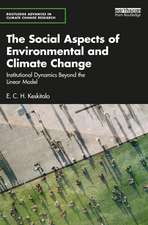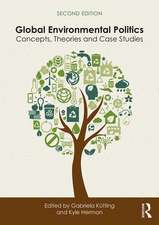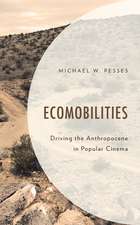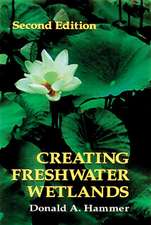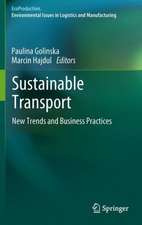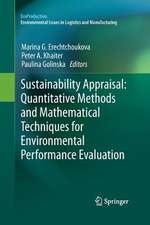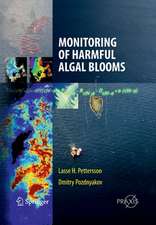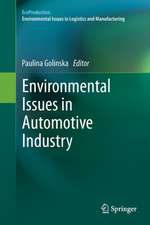Logistics Operations, Supply Chain Management and Sustainability: EcoProduction
Editat de Paulina Golinskaen Limba Engleză Hardback – iul 2014
| Toate formatele și edițiile | Preț | Express |
|---|---|---|
| Paperback (1) | 960.30 lei 6-8 săpt. | |
| Springer International Publishing – 23 aug 2016 | 960.30 lei 6-8 săpt. | |
| Hardback (1) | 964.71 lei 6-8 săpt. | |
| Springer International Publishing – iul 2014 | 964.71 lei 6-8 săpt. |
Din seria EcoProduction
- 18%
 Preț: 999.60 lei
Preț: 999.60 lei - 15%
 Preț: 637.59 lei
Preț: 637.59 lei - 15%
 Preț: 644.18 lei
Preț: 644.18 lei - 24%
 Preț: 1137.30 lei
Preț: 1137.30 lei - 18%
 Preț: 783.81 lei
Preț: 783.81 lei - 18%
 Preț: 963.47 lei
Preț: 963.47 lei - 19%
 Preț: 554.19 lei
Preț: 554.19 lei - 15%
 Preț: 637.59 lei
Preț: 637.59 lei - 15%
 Preț: 645.28 lei
Preț: 645.28 lei - 15%
 Preț: 643.48 lei
Preț: 643.48 lei - 18%
 Preț: 946.55 lei
Preț: 946.55 lei - 20%
 Preț: 644.48 lei
Preț: 644.48 lei - 15%
 Preț: 644.18 lei
Preț: 644.18 lei - 15%
 Preț: 590.30 lei
Preț: 590.30 lei - 18%
 Preț: 722.75 lei
Preț: 722.75 lei - 18%
 Preț: 944.36 lei
Preț: 944.36 lei - 15%
 Preț: 641.53 lei
Preț: 641.53 lei - 15%
 Preț: 646.30 lei
Preț: 646.30 lei - 15%
 Preț: 646.11 lei
Preț: 646.11 lei - 18%
 Preț: 945.79 lei
Preț: 945.79 lei - 15%
 Preț: 640.71 lei
Preț: 640.71 lei - 18%
 Preț: 1006.87 lei
Preț: 1006.87 lei - 18%
 Preț: 785.86 lei
Preț: 785.86 lei - 18%
 Preț: 999.60 lei
Preț: 999.60 lei - 15%
 Preț: 644.95 lei
Preț: 644.95 lei - 18%
 Preț: 788.41 lei
Preț: 788.41 lei - 15%
 Preț: 646.94 lei
Preț: 646.94 lei - 24%
 Preț: 783.26 lei
Preț: 783.26 lei -
 Preț: 389.11 lei
Preț: 389.11 lei
Preț: 964.71 lei
Preț vechi: 1176.47 lei
-18% Nou
Puncte Express: 1447
Preț estimativ în valută:
184.62€ • 200.47$ • 155.08£
184.62€ • 200.47$ • 155.08£
Carte tipărită la comandă
Livrare economică 22 aprilie-06 mai
Preluare comenzi: 021 569.72.76
Specificații
ISBN-13: 9783319072869
ISBN-10: 3319072862
Pagini: 632
Ilustrații: XI, 619 p. 209 illus., 66 illus. in color.
Dimensiuni: 155 x 235 x 39 mm
Greutate: 1 kg
Ediția:2014
Editura: Springer International Publishing
Colecția Springer
Seria EcoProduction
Locul publicării:Cham, Switzerland
ISBN-10: 3319072862
Pagini: 632
Ilustrații: XI, 619 p. 209 illus., 66 illus. in color.
Dimensiuni: 155 x 235 x 39 mm
Greutate: 1 kg
Ediția:2014
Editura: Springer International Publishing
Colecția Springer
Seria EcoProduction
Locul publicării:Cham, Switzerland
Public țintă
ResearchCuprins
Supply Chain Management and Sustainability.- The Impact Of Demographic Changes On Human Resources Management In European Supply Chains- Selected Aspects.- Barriers of the supply chain integration process.- The essence of integration in supply chains and reverse supply chains – similarities and differences.- Supply Chain Integration in View of Secondary Raw Materials.- Integration level measurement system in modeling forward and backward supply chains.- Green supplier selection criteria: from a literature review to a flexible framework for determination of proportionate criteria.- A Model for optimizing traceability of product in a supply chain based on batch dispersion.- Investigating the Readiness of the Grocery Retail Chains for Virtual Supply Chain Technology in Egypt.- Fuzzy TOPSIS/SCOR-based approach in assessment of RFID technology (ART) for logistics of manufacturing companies.- Comarch EDI platform case study: the Advanced Electronic.Data Interchange Hub as a supply-chain performance booster.- Modelling Integration Process Planning in the Supply Chain using SOP approach.- Problems of logistic systems vulnerability and resilience assessment.- The category of risk management in a company with high level of customization.- Literature Study Overseas on SCM Strategy with a State of Art SCM Strategy Model.- Reverse logistics and environmental sustainability.- Single Forward and Reverse Supply Chain.- A case study of H&M’s strategy and practices of corporate environmental sustainability.- Efficient Chemical Management in Global Paint Industry – A Case Study in Sri Lanka.- A Consideration on the Functions of Logistic Parks against Great Disasters.-A Consideration of a Reverse Logistics Network over a wider area.- A Consideration on an Effective Reverse Logistics System for Discarded Tires.- Analysis of Effective Recycle System for Used Personal Computers in Japan.- Optimal Reutilization of the Leased Products in a Closed Loop Supply Chain.- Modeling and optimization of the manufacturing operations.- A Pareto-Archived Differential Evolution Algorithm for Multi-Objective Flexible Job Shop Scheduling Problems.- Sugarcane Harvest Scheduling to Maximize Total Sugar Yield with consideration of Equity in Quality among the Growers.- Production scheduling in food freezing process under the effect of freezer-door opening.- Redefinition of tasks to increase the process capacity of bottlenecks: adjustment to a real case of cutting process of structural profiles of carbon steel.- Examining effect of JITP implementation on performance of Jordanian firms.- Analysis and improvement of the Process Engineer’s levels of competence in a manufacturing company.- Modeling and performance improvement: the Remedy to treat social and environment issues for enterprises in today’s difficult economic climate.- Energy audit methodology and energy savings plan in the nautical industry.- Optimization of the location problems, the inventory management and the vehicle routing problems.- Strategic Inventory Positioning for MTO Manufacturing using ASR Lead Time.- Improving Efficiency of a Process in Warehouse with RFID: A Case Study of Consumer Product Manufacturer.- Model of forklift truck work efficiency in logistic warehouse system.- The integration of environmental foot-printing strategies to the capacitated warehouse location problem with risk pooling.- Storage Location Assignment Considering Three-AxisTraveling Distance: A Mathematical Model.- Solving a Multi-Objective, Source & Stage Location-Allocation Problem Using Differential Evolution.- A Study on the Optimum Location of the Central Post Office in Bangkok, - Applying the Travelling Salesman Problem.- A Closed-Loop Capacitated Warehouse Location Model with Risk Pooling.- A Joint Inventory-Location Model with CO2 Emission Taken into Account in Design of a Green Supply Chain.- Analysis and Suggestion of an E-Commerce Logistics Solution -Effects of Introduction of Cloud Computing Based Warehouse Management System in Japan.- A Simulated Annealing Heuristic for the Vehicle Routing Problem with Cross-docking.- Pollution-Inventory Routing Problem with Perishable Goods.- A Meta-heuristic Approach for VRP with Simultaneous Pickup and Delivery Incorporated with Ton-Kilo Basis Saving Method.- Inventory Routing Problem with CO2 Emissions Consideration.
Textul de pe ultima copertă
The goal of this book is to present a cross-section of research and applications where simulation and optimization technologies have and can enhance sustainability in logistics and manufacturing.
Simulation involves developing a model or representation of a real system, using the model to conduct experiments, and analyzing system performance, all virtually. Thus, simulation is an effective means to assess alternative configurations of a system’s design and operation without being intrusive to the real system. Simulation is also often used to assess performance before the system actually exists. By its very nature the process of simulation is sustainable in that it conserves resources and reduces risks. However, simulation by itself, and when coupled with optimization, provides a powerful means to understand a system’s behavior and performance, the interactions of its components, its dynamics, the influence of variability, and the effects of changes in system parameters, policies, and the environment.
While simulation has been applied in many areas, a review of the literature shows a void in books focusing on the application of simulation and optimization to support the design, analysis, and management of sustainable manufacturing and logistics systems. Similarly, much has been written about sustainability and the use of simulation to assess and improve sustainability, but again, there is a void in its application to manufacturing and logistics. Therefore, the goal of this book is to present a cross-section of research and applications where simulation and optimization technologies have and can enhance sustainability in logistics and manufacturing.
Simulation involves developing a model or representation of a real system, using the model to conduct experiments, and analyzing system performance, all virtually. Thus, simulation is an effective means to assess alternative configurations of a system’s design and operation without being intrusive to the real system. Simulation is also often used to assess performance before the system actually exists. By its very nature the process of simulation is sustainable in that it conserves resources and reduces risks. However, simulation by itself, and when coupled with optimization, provides a powerful means to understand a system’s behavior and performance, the interactions of its components, its dynamics, the influence of variability, and the effects of changes in system parameters, policies, and the environment.
While simulation has been applied in many areas, a review of the literature shows a void in books focusing on the application of simulation and optimization to support the design, analysis, and management of sustainable manufacturing and logistics systems. Similarly, much has been written about sustainability and the use of simulation to assess and improve sustainability, but again, there is a void in its application to manufacturing and logistics. Therefore, the goal of this book is to present a cross-section of research and applications where simulation and optimization technologies have and can enhance sustainability in logistics and manufacturing.
Caracteristici
Provides practical applications of simulation and optimization technologies Gives an overview of eco and sustainable measurements for logistics and manufacturing process evaluation Presents real 3D visualisation techniques Includes supplementary material: sn.pub/extras




